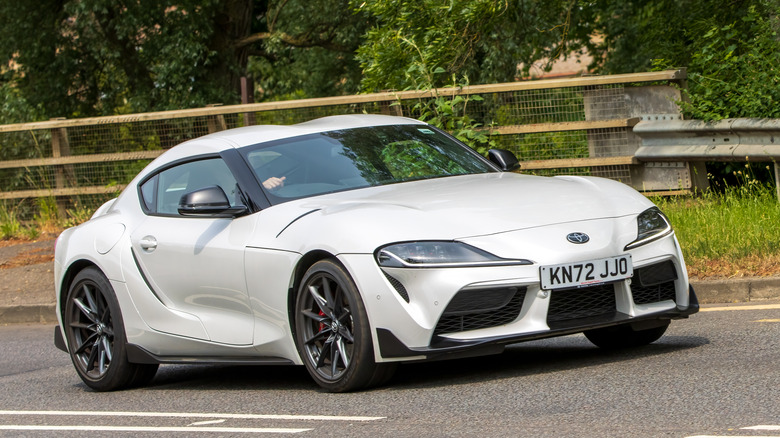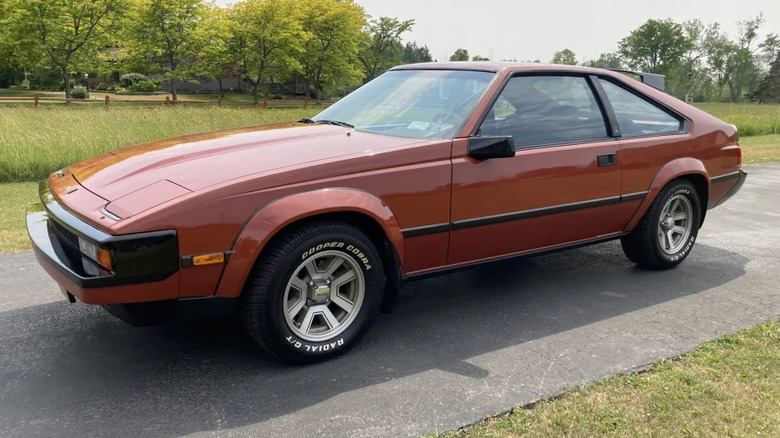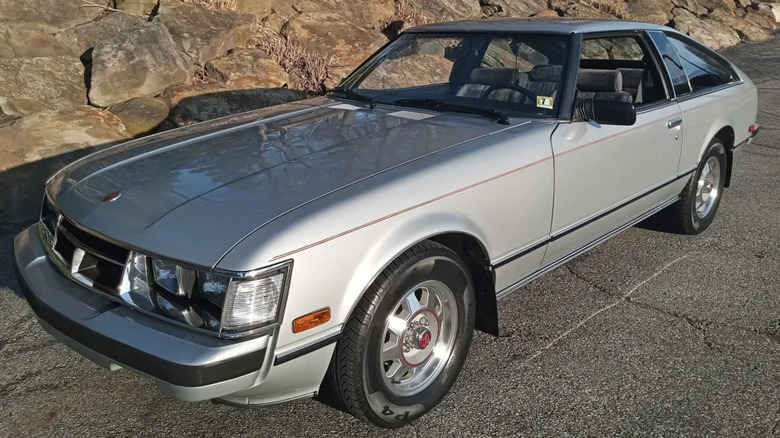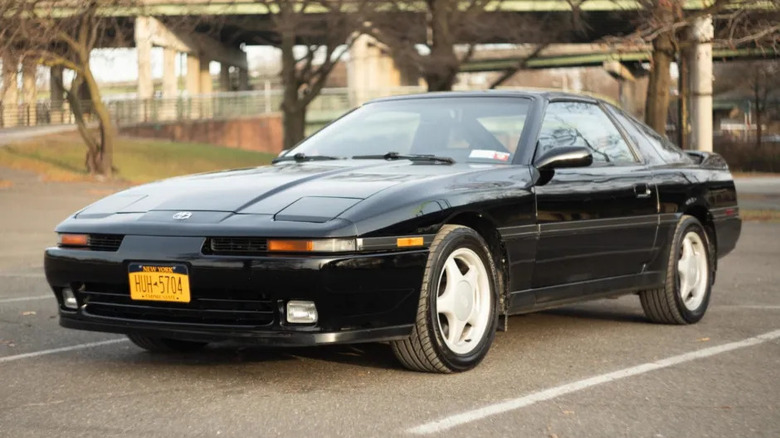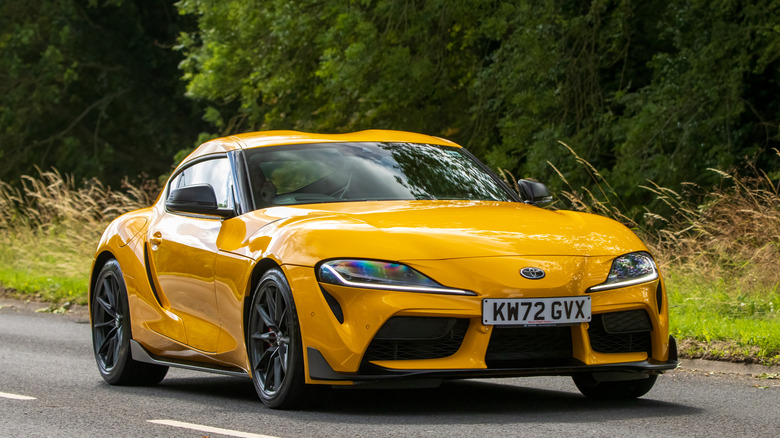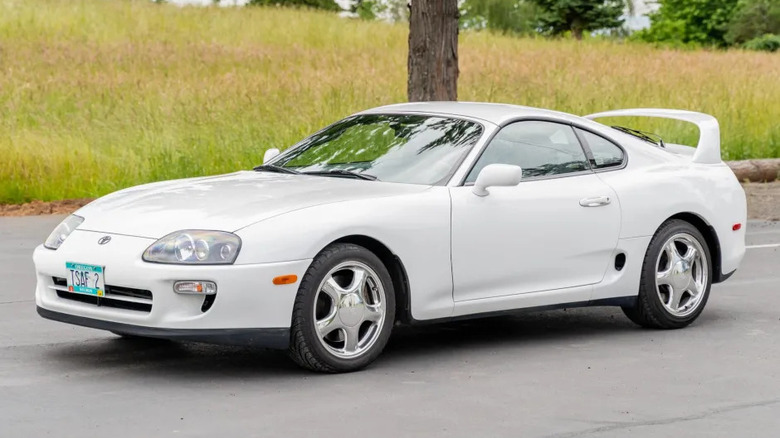Every Generation Of The Toyota Supra, Ranked Least To Most Valuable
Toyota currently ranks as the best-selling automaker in the United States, with just shy of 2 million vehicles sold last year. Toyota's current top domestic sellers are economy-oriented models like the Corolla and Camry or practical choices such as the Tacoma, Highlander, and RAV4. However, the revival of the fifth generation Supra — introduced in 2019 — thanks to a partnership with BMW indicates a shift in focus to performance and the sheer joy of driving. This change is clearly evident in the newest Supra's styling and capabilities; the sleek GR Supra 3.0 can go from 0 to 60 in a blistering 3.9 seconds.
The Supra was first sold globally in 1979, a year after being introduced as the Celica XX in Japan. The earliest Supra was basically a Celica with a front end that had been extended to accept the 2.6 liter straight six motor, and the first generation remained in production until 1981. Toyota collectors still covet the wedge-shaped early Supra, so let's take a look at how the five generations stack up in terms of relative value.
Second Generation: 1981-1985
The least valuable Supra by all measures is the second generation, which encompasses the 1981-1985 model years. The 1985 Supra retailed for about $16,500, and that is roughly the upper end of its current value, although one in less optimal condition is valued at closer to $6,000.
Like the original, the second generation kept the Celica Supra moniker and was known as the Celica XX in Japan. The new Supra got a 2.8-liter inline six-cylinder engine capable of 168 horsepower and 168 pounds-feet of torque, and the Supra made Car and Driver's 10 Best Cars list in 1983 and 1984. Car and Driver also put a 1983 Supra through a 30,000-mile road test, and staff writer Larry Griffin gushed about the Supra's fun factor and reliability. "The Supra is endowed with the same bulletproof character that distinguishes Toyota's entire line of cars," he wrote. "After 30,000 miles, everyone at Car and Driver is still nuts about the Supra."
First Generation:1979-1981
The next most affordable Supra is the oldest in the lineup. The 1979 model originally sold for just under $10,000 and is currently valued at between approximately $5,000 and $16,000, depending on condition. The first generation ran through 1981, and by then, the retail price had climbed to just over $11,000, but the current value of that vintage is not much different from the 1979 model. Those values are taken from dealer pricing guides, but as with any vehicle, the scarcity of rust-free specimens for sale can mean real-world transactions often take place at higher price points.
A one-owner 1980 model with 64,000 miles on the odometer sold last year for a little more than $19,000, and another 1980 model with just 38,000 miles on it sold in 2021 for almost $34,000. There are currently no active listings for first-generation Supras on Bring a Trailer or eBay, but if you have one stashed away somewhere, now might be the time to get it into showroom shape and list it for sale.
Third Generation: 1986-1992
The next most valuable Supras are those from the third generation, which were produced between the 1986 and 1992 model years. The 1991 model had an original sticker price of just over $27,000 and holds a current value of between roughly $12,000 and $44,000, depending on condition. The third generation marked the Supra's split from its Celica roots, as the Celica moved to front-wheel drive, and the Supra went to a rear-wheel drive platform that it shared with the Japanese Soarer model.
For the 1986 model year, only naturally aspirated 2.0 and 2.9-liter inline six-cylinder engines were offered. Still, turbochargers were added to both motors a year later, and eventually, a 2.5-liter turbo six was added to the lineup as well. Arthur St. Antoine of Car and Driver took a 1987 Supra for a two-week test and came away from the experience impressed with the third-generation updates. "Frankly, we were surprised by how much we liked the Supra Turbo after its two-week sojourn in Ann Arbor," he wrote. "We had previously driven a few Turbo prototypes, and we didn't think Toyota had yet found the stuff to compete in the sports-coupe big leagues. After driving our production-model test car, however, we're convinced that all the rough edges have been honed and that everything is now in order."
Fifth Generation: 2019-2023
The current generation of the Supra is not only the most technologically advanced and most capable in terms of performance, but it also has a higher sticker price than any of the previous generations did when new. It also has the second-highest current value of any iteration of the model. A 2023 GR Supra 2.0 is currently valued at an average of just under $46,000 by JD Power, and the 3.0 version is valued at about $10,000 more than that; those prices roughly match the MSRPs for the respective models.
There are a few differences between the Supra 2.0 and 3.0 other than the size of their turbocharged inline four-cylinder engines and sticker prices; the 2.0 is more than 200 pounds lighter and gets marginally better fuel mileage. While the two models are nearly identical on the outside, the 3.0 adds heated leather seats, a head-up display, and a superior sound system.
Fourth Generation: 1993-2002
The most valuable Toyota Supra is the fourth generation, which was produced between the 1993 and 2002 model years. The 1998 model carried a sticker price of just under $31,000, but that vintage has appreciated in value to between about $35,000 and $65,000 today depending on condition, although some examples can go for even more; two low-mileage 1998 Supras sold last year for well over $100,000 each.
The fourth generation Supra was fitted with a twin-turbo 3.0 liter straight six motor that produced 312 horsepower and 315 pounds-feet of torque, enough to slingshot the 3,265 poundcoupe from 0-60 in 4.7 seconds and give it a top speed of 177 mph. Supra buyers could opt for a removable targa top, and the 18.5-gallon fuel tank and 22 mpg highway fuel mileage gave drivers a 400-plus mile freeway cruising range.
Despite all of these compelling qualities, the U.S. market's growing aversion to two-door coupes as the 21st century dawned led to the Supra being dropped after the 2002 model year. The nameplate then sat dormant until 2019, when it returned back to its current form.
